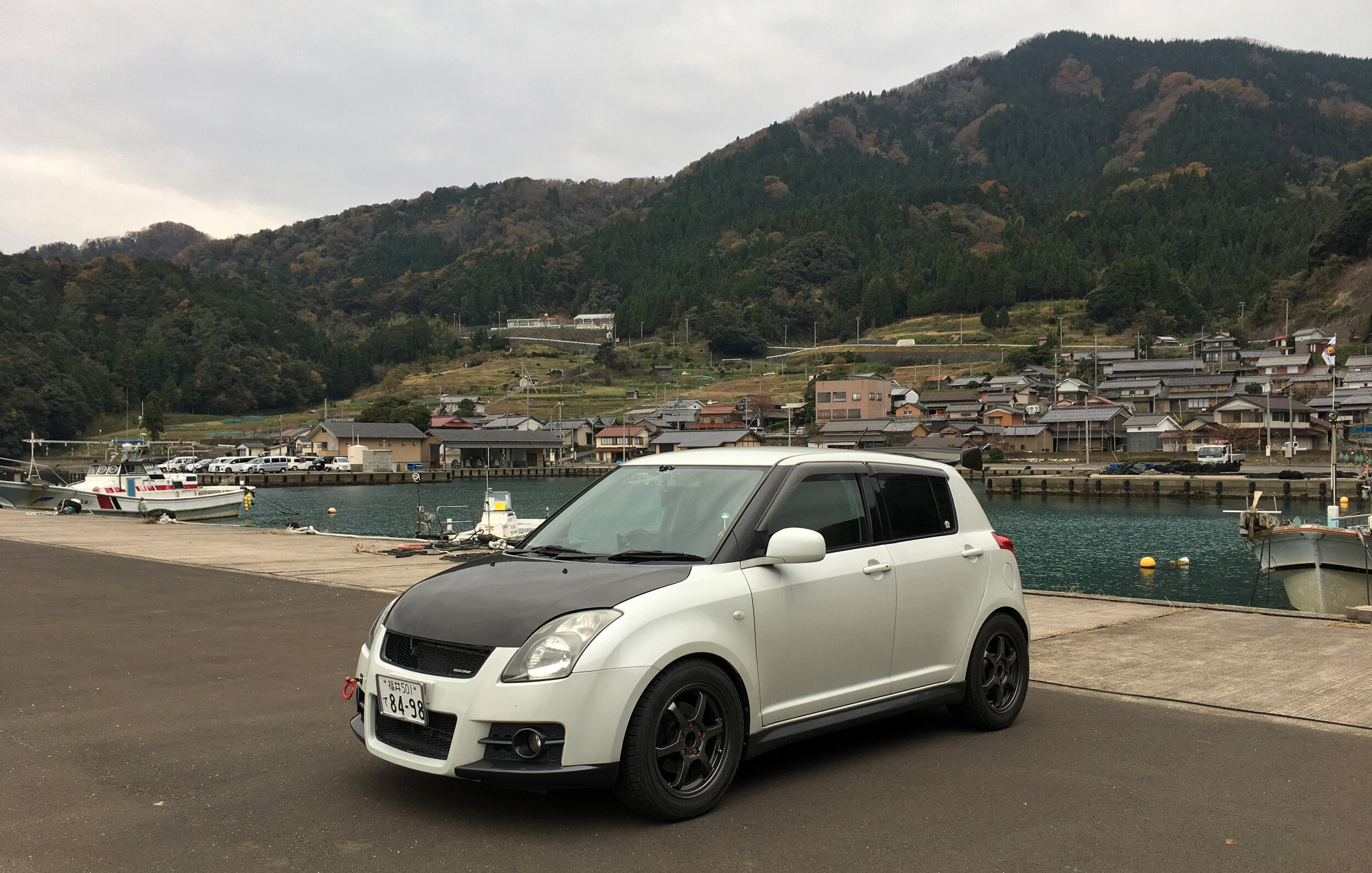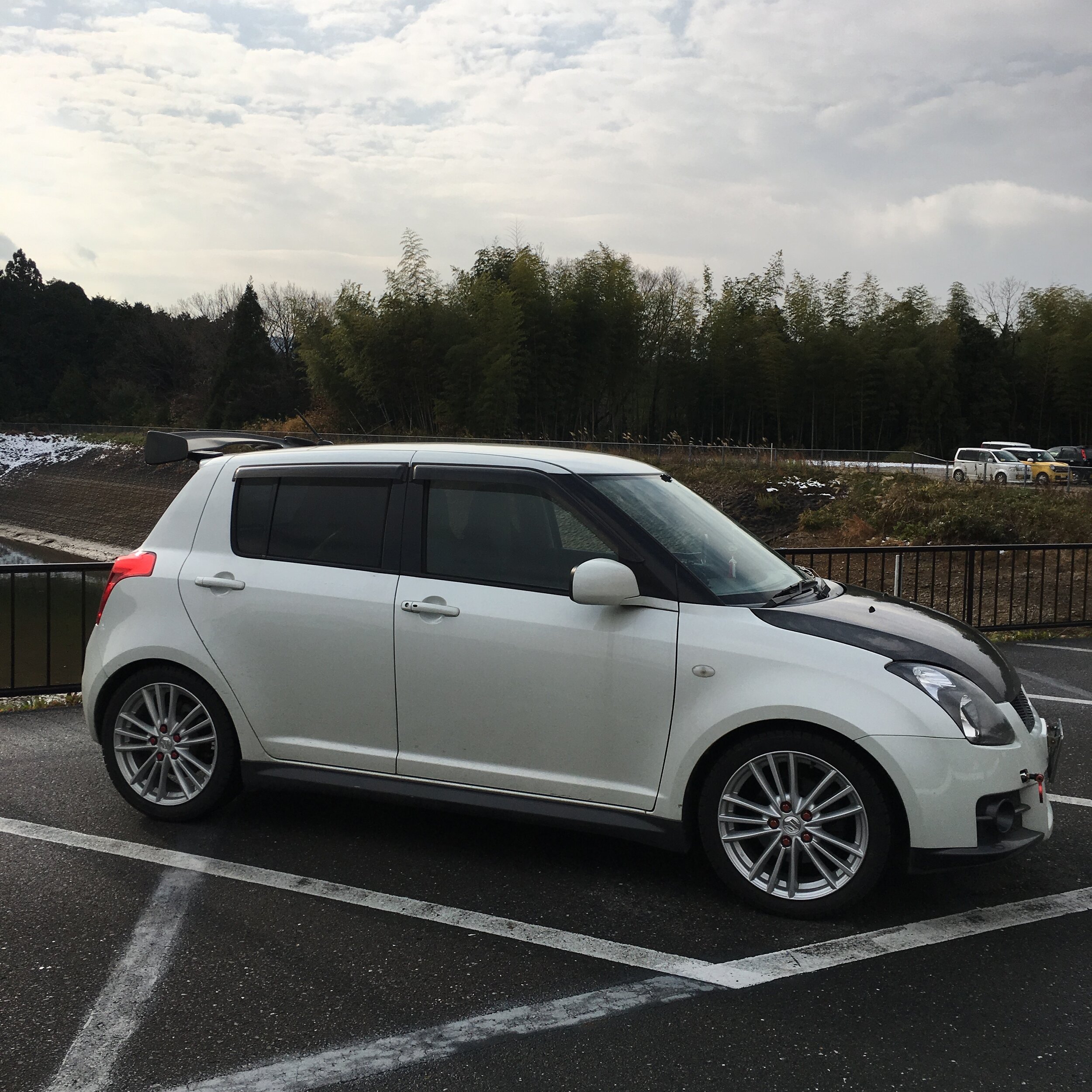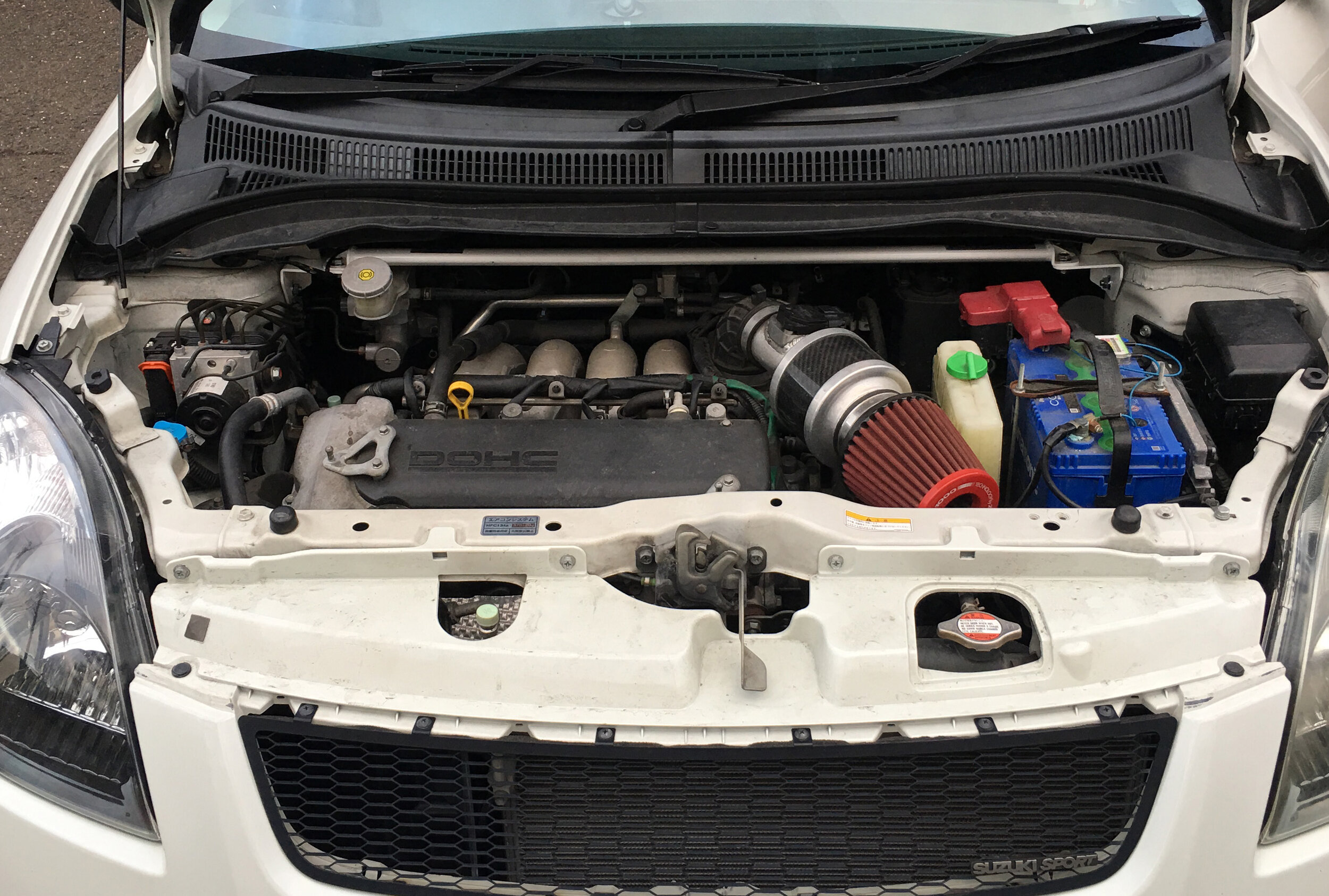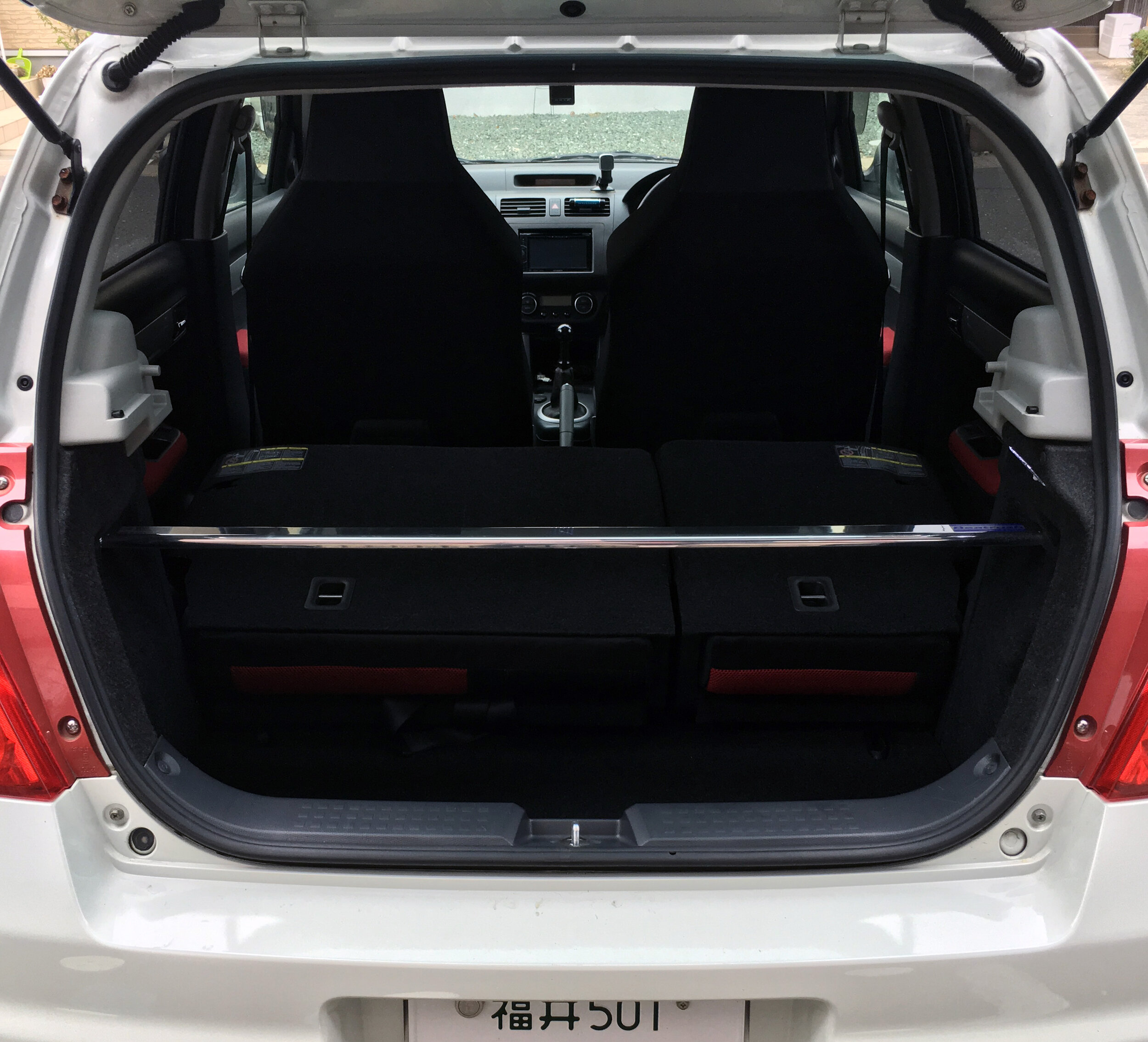[ Swift Sport ] Okuyama Carbing and Laile Beatrush Strut Tower Bars (Modifications, Part 2)
Not long after buying my Swift Sport, I started modifying my car and putting a few bolt-ons <l>, because I can never be happy with stock. As nice as these Suzuki Swift Sports come from the factory, there is always room for improvement.
Sometimes, the modifications don’t work out the way I wanted them. I suppose aftermarket wheels on tall, wide winter tires are considered aftermarket modifications. As mentioned last time, I bought a set of winter wheels and tires, required in wintertime for many parts of Japan. They are a size taller and wider, so they rubbed a bit on the lowered Suzuki Sport suspension I had. At first, the rubbing wasn’t so intrusive, a few dips and bumps would cause fender scraping which would get severely worse if I had a passenger.
I raised the suspension a bit in hopes of minimizing the rubbing. A bit wouldn’t be a problem to me. I thought until a few months into driving on them, I hit a hard dip and all of a sudden, I noticed my front windshield had a hairline crack. I was frankly quite shocked. Did the crack appear as a result of the tires hitting the fenders hard, causing the crack? Or was it simply a result of an exacerbation of pre-existing stress cracks in the window? Most likely, it was a combination of the two.
While I personally didn’t mind driving around with a minor stress crack in my windshield (which slowly grew in length), it would not pass shaken, which was due in a few months. I prepared my wallet for the worst because I knew a front windshield would not be cheap.
Of course, soon after that incident, I knew I needed new tires immediately that would not further any damage. I settled on a pricey set of Suzuki Swift Sport wheels from the ZC32S model year (2010-2016). These wheels are slightly larger and wider, at 17x6.5 compared to my stock wheel size at 16x6. Unfortunately, due to the late winter timing when winter tires are at their peak pricing, I had to pay a slight premium about 30,000¥ with a set of nearly-new winter Nankang Corsafa studless tires which are appropriately sized for my car.
The wheels themselves were also nearly mint, with no curb damage and only a few minor rock chips. However, to me, these multi-spoke, bright silver wheels don’t really match the flat, simple lines of the car itself. What do you think?
My shaken was due in late January 2018, so over winter vacation, I had to replace the front window at a miserable cost of almost 80,000¥. Add to the cost of the inspection for a regular white plate and other maintenance, the total cost hit me about 180,000¥ ($1700). To put it lightly, that really hurt my wallet.
My mechanic ordered some China-sourced H4 LEDs to replace the messy wires of the old PIAA HID bulbs installed on the car. These cleaned the engine bay up a bit and are genuinely very bright. Having used this brand himself for a few months prior, the quality seemed to be good and haven’t burned out yet (which is quite likely for many lower-quality sets).
Carbing Okuyama Front Strut Tower Bar
My next modification would not (or should I say, could not) come until a few months later. After cracking my windshield driving around the mountainous, bumpy roads of Japan, I considered strengthening the perceived chassis rigidity in my little box-shaped hot (warm) hatch.
Most traditional front strut tower bars connect the tops of the strut towers, but due to the compact design and dimensions of the Swift, it is actually rather difficult to have a bolt-on product that works the same as the Cusco piece on my Alto. I found a STB offered by Tryforce that appears to bolt on directly to the top of the strut towers, but judging by the thin sheet metal and tiny mounting points, it looks extremely flimsy. I’m not an engineer by any means, but there is no possible way it could do anything noticeably beneficial.
Well, let’s be fair, the front of the Swift is probably already fairly rigid, so would anything else benefit? Products such as those offered by Laile Beatrush and Carbing Okuyama seem to offer stiffer solutions. These products attach to the chassis near the strut towers near the firewall.
Initially, I wanted the Laile Beatrush unit because I have good experience with their products on my old Mitsubishi Evo, but I liked the more rigid design of the steel Carbing Okuyama one, as it is one solid piece of steel. 16000¥ later, it came in the mail a few days.
It installed quickly in under an hour, using a few bolts through pre-existing holes in the chassis, so there is no permanent modification.
After the install, I don’t honestly think I felt a huge difference in driving dynamics. While bumps felt slightly more isolated, overall I’d say turn-in and handling was largely the same as before. Sadly, I’ll be honest and say this bar might be more automotive bling than an upgrade.
Laile Beatrush Rear Strut Tower Bar
After my Carbing bar install, I found a deal for a Laile Beatrush rear STB, used for 8000¥, a few weeks later. While the performance and overall stiffness of the rear of my Swift was not at all lacking in comparison to my Alto, I figured for the price it would be a cool addition and the fact that the rear of a hatchback really could benefit from overall stiffness.
Installing the bar was actually really simple and only took about a half hour of actual work. First, the carpet had to be peeled back a bit to expose the mounting points. The bar used existing rear seat latches, which are hard points bolted into the frame. Four bolts for each side and the bar is installed. I had to cut the interior carpeting to poke the bar through, but everything looks clean and is easily reversible, unlike the cut I had to make for the rear STB for my Evo.
In theory, this bar adds rigidity to the rear of the car on rough roads and corner transitions, as it adds two additional points of contact between the empty rear “box” of a hatchback car. This arguably does more for this car than the front strut.
The main drawback of this bar is a major sacrificial loss to the already limited rear trunk space. It cannot be quickly removed since the bolts are hidden under the panels, so large objects such as suitcases will only fit now with the rear seats folded.
As for driving impressions, I think I’m not wholly impressed. While I do feel marginally more predictability in hard corners, the cost to actual performance is pretty poor. Overall I feel the Swift Sport is already well designed and reasonably stiff, so additional structural bars like these two will not transform the car. Either way, they add a bit of automotive "jewelry," for whatever that is worth.








